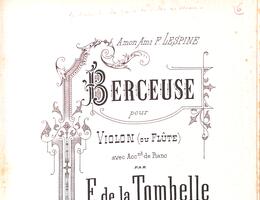Berceuse for violin and piano
In the 19th century, the aim of the berceuse was not necessarily to help children fall asleep. However, although it abandoned the popular tenor of children’s songs, it derived from an ideal of simplicity underpinned by a rhetoric which made it a true genre: a slow or moderate tempo, regular rhythmic figures setting up a gentle rocking motion, transparent textures, a melody that was both legato and very tuneful, dynamic markings which were essentially piano, and the absence of contrasts. La Tombelle’s Berceuse for violin and piano, published by Richault around 1895, obeys these unspoken rules. The melody on the violin, which plays with a mute throughout, mainly inhabits the middle and upper registers, while the right hand of the piano unfurls in delicate quaver beats which unify the piece. Although the harmony avoids sudden changes, which would be out of place in this type of music, it is, on the other hand, clothed in subtle iridescences, introduced in particular by smooth shifts from minor to major (as a result, the introduction in the piano is in A minor, shaded with touches of modality, while the key of A major is established when the violin enters), passing chords on numerous pedal points in the bass, and a lovely modulation to F major, a third below the principle key. The score stipulates which string the violinist should play on several occasions: a direction (by the composer or the publisher?) which has an impact on the timbre, but may also have had a pedagogical function. It is easy to imagine this Berceuse played by amateurs in a salon cultivating the virtues of Bourgeois family life.

